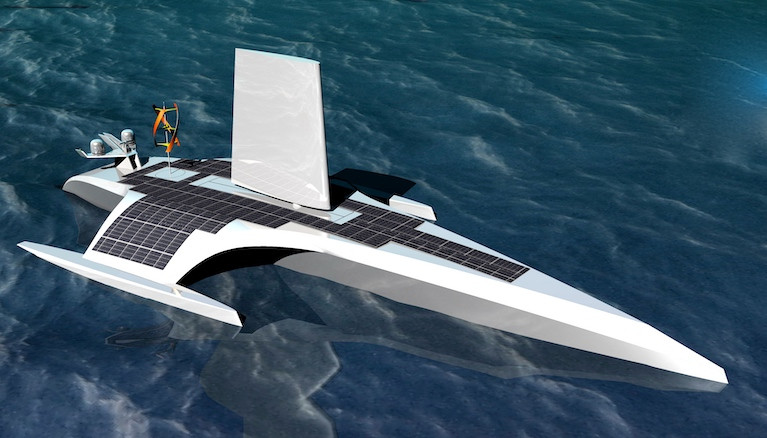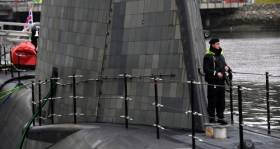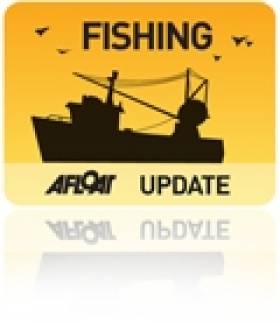Displaying items by tag: submarine
"Maverick" Design May Have Contributed to Titan Submersible Implosion- New York Times
The “maverick design” of the Titan submersible made it more susceptible to implosion, the New York Times has said.
The material used for the submersible may also have been a factor, the newspaper says.
Five people – businessman Hamish Harding, OceanGate owner Stockton Rush, Suleman Dawood with his father, Shahzada Dawood, and Paul-Henri Nargeolet – died last month during a dive in the submersible to the wreck of the Titanic.
A New York Times report quotes Tim Foecke, a retired forensic metallurgist, as stating that the change in hull geometry from a tight sphere to a lengthy tube may have contributed to Titan’s catastrophic failure.
“A spherical hull distributes the stress evenly, making it the best shape for resisting the compressive forces of the abyss,” the newspaper says.
Any other shape will “tend to deform unevenly”.
A larger hull needs to be stronger and thicker to withstand the same pressure as a smaller one, Foecke explained.
Experts who spoke to the newspaper compared Titan to Alvin, a research submersible with an all-titanium hull which has completed more than 4,500 dives since 1973.
It notes that OceanGate created most of Titan’s hull out of carbon fibre, rather than the conventional titanium used for Alvin. Experts said the risky design saved money.
Titan’s hull was larger and held two more passengers than Alvin, which fits three. In three years of dives, OceanGate charged up to 250,000 US dollars per person to visit the Titanic.
Read more in the New York Times here (subscription required).
Rescuers are racing against the clock to locate and retrieve a tourist submarine that’s gone missing while on a dive to view the Titanic wreck site.
According to The Irish Times, prominent maritime experts and explorers are among the five people on board the mini submarine which lost contact with the surface less than two hours after going below on Sunday afternoon (18 June).
The missing vessel is OceanGate’s Titan, which since 2021 has been running expeditions for paying guests to the wreck of the ill-fated, Belfast-built ocean liner some 4km below the North Atlantic, as previously reported on Afloat.ie.
Search teams from the US and Canada are combing the area some 600km off Newfoundland in a “complex” operation as it is unknown whether the mini sub has surfaced or remains on the ocean floor.
And time is of the essence as officials believe the sub’s crew may run out of air between Wednesday (21) and Thursday (22 June).
The Irish Times has more on the story HERE.
Britain Tried to Claim State Immunity in Bid To Reclaim Sonar Array from Submarine Which Snagged Irish Fishing Vessel
The British government tried to claim State immunity when seeking to recover a sonar array from one of its submarines which dragged an Irish fishing vessel backwards in 1989.
As The Irish Independent reports, State Papers reveal that Irish civil servants believed an agreed settlement between the British authorities and the skipper of the MV Contestor was preferable to the incident going to court.
A department memo dated September 13th 1990, which has been released as part of the State Archive, outlined concerns over the potential embarrassment of British legal action being triggered for the recovery of the towed sonar array.
The incident on September 12th 1989, occurred 40km east of Skerries, Co Dublin, when the MV Contestor alerted the Shannon-based Marine Rescue Co-Ordination Centre at 19.20 hours.
The vessel was fishing in the Irish Sea when its skipper, Sean Daly, reported that its gear had snagged a submerged object, and then said it was being towed backwards.
The vessel was able to break free, and recovered a towed sonar array from a submarine with the markings: “Admiralty Ref - Patrick Engineering Co – Serial No 119 of 1987.”
Irish officials raised serious concerns over the incident with the British authorities as it came less than a decade after an Irish trawler, Sharelga, sank after an incident with a British submarine.
Department of Foreign Affairs officials were notified on September 15th, 1989 that Mr Daly had initiated legal action for salvage under the Merchant Shipping Act, 1894 – with the buoy being retained by the Irish authorities "until payment is made for salvage".
A department briefing note on September 13th, 1989 noted that the area involved is "marked on Admiralty charts as a submarine exercise area and fishermen are cautioned to keep a lookout for submarine activity".
Irish officials were subsequently made aware that Britain had obtained advice from an Irish lawyer that they could claim "state immunity" – which would prevent salvage being claimed and would involve the return of the sonar array.
Irish civil servants decided it was best not to give specific advice to the British Embassy but to make it clear that a negotiated settlement was in everyone's best interests, The Irish Independent reports.
"I suggest that we reply informally to the Embassy on the line that – the question of state immunity is for the courts to decide and we are not in a position to offer advice on the matter," J Farrell of the Anglo Irish Section wrote on September 13, 1990.
"We would naturally prefer if an agreed settlement could be achieved without the need for litigation."
The memo concluded with “the warning that the Department of Foreign Affairs could not interfere as requested by the British Embassy, given the statutory obligations on the Receiver of Wrecks under the Merchant Shipping Act".
Read more in the Irish Independent HERE
Transatlantic Un-Crewed Ship? Why Not Ocean-Crossing Unmanned Nuclear Submarines?
Today (Wednesday) in Plymouth in England, the Mayflower Autonomous Ship is expected to have her official launch, though the word is she has been test floated in advance. If that's the case, it was a prudent move, for although un-manned ships using Artificial Intelligence and other technologies have been ideas in the making for some time, this particular 15-metre trimaran – called Mayflower in honour of the 400th Anniversary of the Pilgrim Fathers' voyage in the original Mayflower from Plymouth in Devon to what became Plymouth in Massachusetts – is really pushing the envelope in just about every direction, as she will be reliant on AI, solar power and the auxiliary support of a wing sail to get her alone across the Atlantic.
Built in Gdansk in Poland for a partnership which includes ProMare and IBM, this 50-footer was originally supposed to have been launched at the beginning of the summer and to be starting her voyage around now, after extensive sea trials. But the pandemic has delayed everything, and the pioneering Transatlantic voyage is currently planned for early next summer after trialling through the winter.
Building the Mayflower Autonomous Ship in Gdansk
This may be no bad thing for the promoters of the project, as the western side of the North Atlantic at the moment is experiencing the most active tropical storm and hurricane-generating conditions ever recorded. Doubtless, we'll be feeling the effects of that in Ireland in due course, but right now the idea of sending a slip of a thing directly to America ultimately relying on solar power on a northern route re-tracing the original Mayflower's course of 1620 might well prove to be a test too far.
 Ghost from the past. The two Mayflowers: the original took 66 days to get across the Atlantic in 1620
Ghost from the past. The two Mayflowers: the original took 66 days to get across the Atlantic in 1620
In fact, if you're contemplating an east-west Transatlantic voyage across the direct route on the North Atlantic in the next few weeks, for your comfort and safety we'd recommend hopping aboard a west-bound nuclear submarine. Of course, this is the negation of using solar power. But as this department of Afloat.ie has been in cahoots for a long time with that secret society which believes we're ultimately going to have to rely on nuclear power to save the planet, the entire idea seems utterly logical, and going underwater makes sense.
For it's on the interface between sea and air that boats and ships get battered about. Go silent, go deep, go smooth. Back in the day when NATO saw large fleets exercising in harmony, other navies noticed that around mid-day there seemed to be a slackening of activity among French submarines. Between 1230 hrs and 1430 hrs, you wouldn't hear a word from them at all. It seems they all gently descended to their own favoured smooth spots on the seabed, and there they sat in order to enjoy a proper French lunch – wine and all – totally undisturbed.
 French Nuclear submarine of the Shortfin Barracuda Class. A descent to the peace of the seabed for an undisturbed lunch was, as they say in the Michelin Guide, "well worth the detour".
French Nuclear submarine of the Shortfin Barracuda Class. A descent to the peace of the seabed for an undisturbed lunch was, as they say in the Michelin Guide, "well worth the detour".
So maybe if we want to send unmanned "ships" reliably across the Atlantic, we should be thinking under-water well below those bumpy waves, and use crew-less nuclear subs. The technology would be mind-boggling. But apparently some of the computing power being deployed for the Mayflower Autonomous Ship was originally devised to predict risks in international banking, and just look how successful that has been over the years…….
Submarine in 'Near-Miss' with Stena Ferry In Irish Sea
#ferries - A Royal Navy nuclear-powered submarine has been involved in a near-miss with a ferry in the Irish Sea.
An investigation writes The Irish Times, has been launched into the previously unreported incident, which occurred on November 6th.
The ferry was Stena Superfast VII, which operates between Northern Ireland and Scotland.
It has a capacity for 1,300 passengers and 660 cars.
The submarine was submerged at the depth needed to extend its periscope above the surface of the water.
The Royal Navy would not confirm which of its 10 submarines was involved.
They are all nuclear-powered but only four carry Trident nuclear missiles.
A spokesman for the Marine Accident Investigation Branch (MAIB) said: “In November, we were notified of a close-quarters incident between the ro-ro [roll-on/roll-off] ferry Stena Superfast VII and a submarine operating at periscope depth.
To read more on the incident involving the ferry that operates Belfast-Cairnryan (not Stranraer as published) in the newspaper click here.
Hunt For 'Russian Submarine' Spotted Off Scottish Coast
#Submarine - RAF aircraft have been joined by French and Canadian counterparts as well as a Royal Navy frigate in the search for a Russian submarine reported to have been seen off the Scottish coast.
According to The Scotsman, it's believed the search has been ongoing for more than a week after a vessel was detected north of Scotland, though the UK's Ministry of Defence would neither confirm nor deny such a search was taking place.
The news comes some three months after a Donegal crab boat reported a near-miss with a submarine off Tory Island on Ireland's North Coast.
It's not known what country's military that submarine represented, but it is feared that Russian subs might be secretly surveying undersea internet cables for potential strategic advantage.
However, searches for such rogue submarines have been blamed by environmentalists for prompting significant whale strandings, as reported on Afloat.ie earlier this year.
The Scotsman has more on the story HERE.
Donegal Crab Boat Reports Near-Miss With Submarine
#Fishing - Donegal fishermen are counting their lucky stars after a near-miss with a submarine last week.
As TheJournal.ie reports, Seán Ó Briain says his crab boat came within just 200 metres of the sub, which appeared with little warning about 22km northwest of Tory Island last Thursday (3 September).
While the "general rule", according to Ó Briain, is to give right of way to fishing vessels such as his when setting or pulling pots, in this case "we needed to slow down to let the submarine pass".
Ó Briain added that daylight added to their luck both this time and in a similar incident this time last year, as they were able to take evasive action.
The story will bring to mind an Ardglass skipper's complaint that his prawn trawler was dragged backwards by a submarine in the Irish Sea this past April – an incident finally confirmed by the Royal Navy on Monday (7 September).
According to the Belfast Telegraph, Britain's Ministry of Defence admitted to the incident, which caused an estimated £10,000 worth of damage to Paul Murphy's boa and fishing gear, after "new information" came to light. More on the story HERE.
#MarineScience - Following its issue by the Central Bank last year, the limited edition Silver Proof coin commemorating John Philip Holland, the Irish-born inventor of the modern submarine, was presented to Taoiseach Enda Kenny and Marine Minister Simon Coveney during their recent visit to the Marine Institute.
Highlighting the significance of Ireland's strong maritime history, Marine Institute CEO Dr Heffernan explained how this country "is at the cutting edge of international marine research driving ocean discovery and exploration.
"Supporting the Irish-led first transatlantic mapping survey from Newfoundland to Galway this coming month [June 2015], the Marine Institute's national research vessel RV Celtic Explorer will be using its extensive multibeam sonar equipment mapping parts of the Atlantic seabed."
Dr Heffrnan added: "The oceans are the life support system of our planet – producing half the oxygen we breathe; providing us with a wealth of resources including food, minerals and energy; as well as affecting our moderate climate in Ireland. It is essential that we continue to improve our understanding of how the ocean impacts our live."
By 2020, in partnership with the Atlantic Ocean Research Alliance between the EU, Canada and USA which was established by the signing of the Galway Statement in 2013, Dr Heffernan says "we aim to be able to predict the major risks and changes in the dynamics of the Atlantic Ocean.
"Just as John Philip Holland set out to discover the depths of the sea over one hundred years ago, we continue this quest of discovery and innovation through advanced technology."
Skipper Blames 'Submarine' For Irish Sea Trawler Incident
#Fishing - Was a fishing boat dragged backwards by a submarine in the Irish Sea?
That's what the crew of an Ardglass prawn trawler are saying after an incident yesterday afternoon (Wednesday 15 April).
As the Belfast Telegraph reports, skipper Paul Murphy says the 60-foot wooden-hulled trawler was some 18 miles off the coast, near the Calf of Man, when something snagged its nets.
“Without warning, were were stopped and pulled backwards very violently at around ten knots which is the top speed of the vessel. I really thought that was it," he says.
"It was fortunate that one of the steel ropes holding the net snapped or we would have been pulled under very quickly."
Murphy says the scary episode only lasted a few seconds, but still managed to cause thousands of pounds' worth of damage to his fishing gear – and alleges that the culprit was a submarine.
The Belfast Telegraph has more on the story HERE.
It wasn't the only drama in the Irish Sea yesterday, as a coastguard helicopter was scrambled to rescue three from a fishing boat that sank off Wicklow.
Central Bank Issues Commemorative Coin in honour of Irish Submarine Inventor John Philip Holland
#submarine – The Central Bank of Ireland launched today a €15 limited edition Silver Proof collector coin to commemorate John Philip Holland [1841 - 1914], the Irish born inventor of the modern submarine.
Speaking at the launch at the Marine Institute, Oranmore, Galway, Central Bank Director of Currency and Facilities Management, Paul Molumby said: "This is the first in a new series that the Central Bank will issue to honour Ireland's impressive scientific and technological tradition. John Philip Holland's life and achievements were extraordinary. He played a significant role in the development of submarine navigation and following his emigration to the USA, he designed the first working submarine."
Dr Peter Heffernan, CEO Marine Institute said: "We're delighted to host the launch of the Central Bank's commemorative coin here today to honour John Philip Holland, the Irish born inventor of modern submarine. As a nation we have a strong tradition of innovation and we at the Marine Institute are very proud to maintain that link with the history of marine technology - we named our remote operated vehicle (ROV) after John Philip Holland the Irish born inventor of modern submarine.
With the ROV Holland I, we honour his legacy through important recent scientific discoveries such as the surveys of mid-Atlantic volcanic vent fields and the unique new animal communities on the deep canyons on our continental slope, as well as working on crucial fisheries, environmental and climate changes missions and assisting in the development of new marine sensor technologies.
This event would have also been well received by the late Commander Bill King who lived in Oranmore, Galway. Commander King had commanded the submarine Snapper during World War II, in which he won the DSO and DSC while patrolling the coast of Norway. In his later years he frequently addressed meetings urging people to seek adventure in their lives, particularly having joined the Royal Navy at a young age of 13.
The coin features a representative image of the inventor's hand poised to place the final stroke of a technical drawing of the USS Holland, complete with a decorative nautilus spiral with the obverse bearing the traditional representation of the Irish harp. The coin, which was designed by Mary Gregoriy, is part of the Irish Science and Inventions coin series, and has an issue limit of 10,000 units.
The Holland coin will be available to the public from Tuesday 2nd September 2014. Coins can be purchased by downloading an order form from www.centralbank.ie, by phoning 1890 307 607 or directly from the Central Bank on Dame Street in Dublin at a cost of €44.

































































